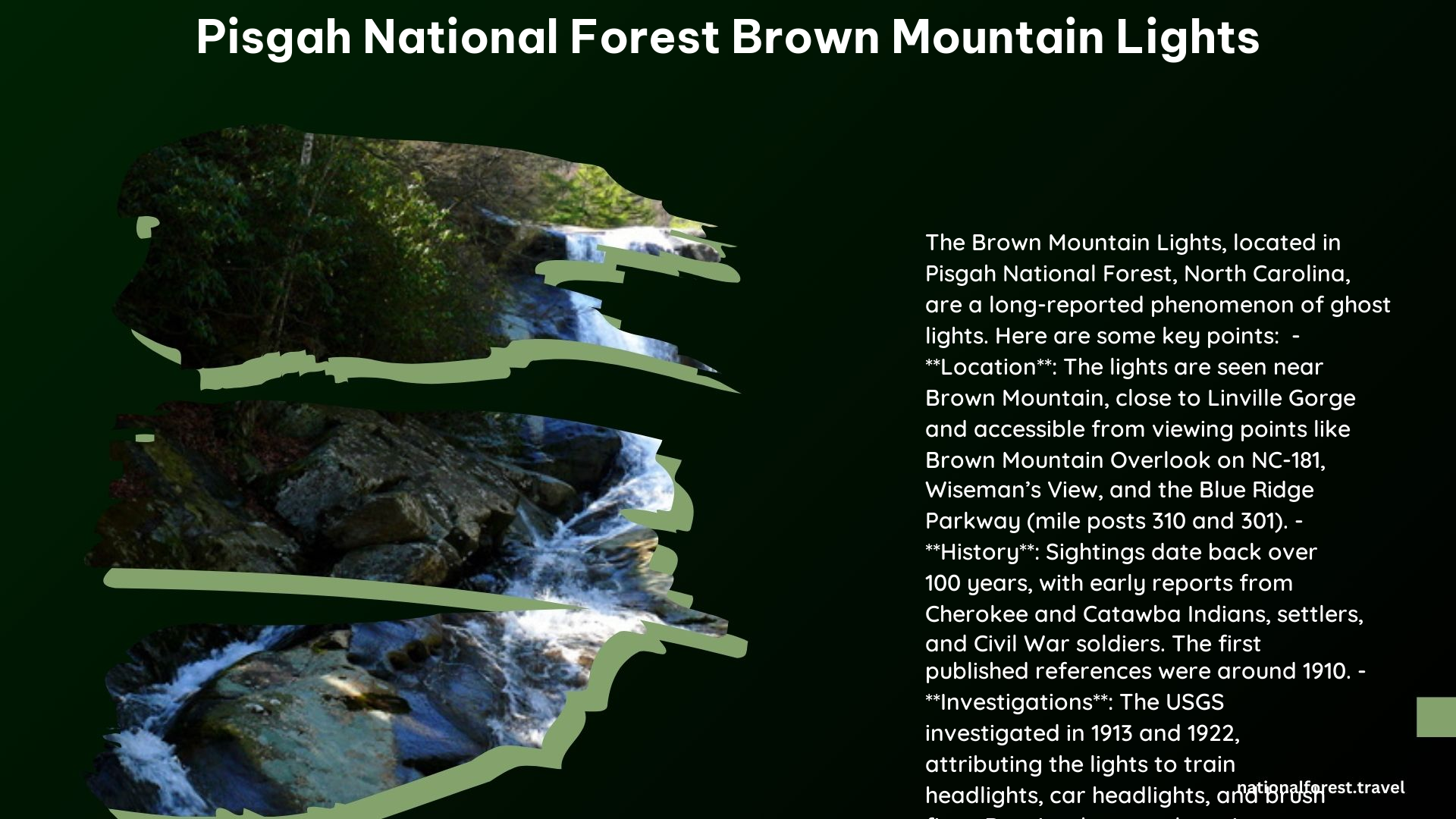The Pisgah National Forest Brown Mountain Lights are an unexplained visual phenomenon observed for over a century in the Pisgah National Forest, North Carolina. These mysterious lights, seen around Brown Mountain, have sparked scientific investigations, local legends, and paranormal theories. Despite numerous studies, the true nature of these lights remains elusive, attracting curious visitors and researchers alike to witness this enigmatic spectacle in the Appalachian Mountains.
What is the History of the Brown Mountain Lights?

The Brown Mountain Lights have a rich history dating back to the early 20th century. Here’s a chronological overview of key events and investigations:
- 1910: Earliest published references to the lights coincide with the introduction of electric lighting in the area.
- 1913: First USGS investigation by D.B. Sterrett attributes lights to locomotive headlights.
- 1922: Second USGS investigation led by George R. Mansfield confirms lights as train headlights, car headlights, and brush fires.
- 1970s: ORION experiment attempts to replicate the lights without conclusive results.
- Recent years: Ongoing studies by Appalachian State University researchers Dr. Dan Caton and Lee Hawkins.
Despite scientific explanations, local legends persist, including:
- Cherokee legend of searching souls
- Lost hunter and slave story
- Civil War and Revolutionary War ghost theories
- UFO-related speculations
Where are the Best Viewing Locations?

To witness the Brown Mountain Lights, consider these top viewing spots:
- Brown Mountain Overlook
- Location: NC-181, 15 minutes from Linville Falls Community
- Accessibility: Car-friendly
-
Amenities: Parking lot, scenic overlook
-
Wiseman’s View
- Location: Linville Gorge, Pisgah National Forest
- Access: Short paved trail from parking area
-
Features: Observation decks with eastern views
-
Lost Cove Overlook
- Location: Blue Ridge Parkway (mile posts 310 and 301)
- Accessibility: Car-friendly
- Amenities: Parking lots, scenic overlooks
What are the Theories Behind the Brown Mountain Lights?
The Brown Mountain Lights have sparked various theories:
Scientific Explanations
- Early USGS attributions: Train headlights, car headlights, brush fires
- Geomagnetic activity or meteorological phenomena (unconfirmed)
- Ball lightning hypothesis
Folklore and Local Legends
- Cherokee women’s souls searching for fallen warriors
- Civil War and Revolutionary War ghost stories
- UFO activity theories
Paranormal Investigations
- Joshua Warren’s LEMUR team: Recorded anomalous energies
- Dr. Dan Caton and Lee Hawkins: Documented rare, unexplained sightings
When is the Best Time to View the Brown Mountain Lights?
To maximize your chances of witnessing the Brown Mountain Lights:
Optimal Seasons
- Fall is considered the prime viewing season, especially after rainfall
Ideal Conditions
- Dry, crisp autumn evenings
- Clear night skies with minimal light pollution
Viewing Tips
- Visit during fall months
- Choose a clear night
- Arrive after sunset
- Be patient and observant
- Bring binoculars or a telescope for better viewing
How Do Scientific and Paranormal Explanations Differ?
The Brown Mountain Lights have been subject to both scientific and paranormal investigations:
| Scientific Explanations | Paranormal Theories |
|---|---|
| Train and car headlights | Ghost lights from lost souls |
| Brush fires | UFO activity |
| Geomagnetic phenomena | Interdimensional portals |
| Ball lightning | Spirit energy manifestations |
While scientific studies have attempted to explain the lights through natural phenomena, paranormal investigators argue for supernatural origins based on eyewitness accounts and anomalous energy readings.
What Should Visitors Know Before Seeking the Brown Mountain Lights?
If you’re planning to search for the Brown Mountain Lights:
- Safety First
- Inform someone of your plans
- Bring appropriate gear for nighttime outdoor activities
-
Stay on designated trails and viewing areas
-
Respect the Environment
- Follow Leave No Trace principles
-
Avoid disturbing wildlife or vegetation
-
Be Prepared
- Bring warm clothing, even in summer
- Pack water, snacks, and a first-aid kit
-
Carry a reliable flashlight or headlamp
-
Manage Expectations
- Sightings are not guaranteed
-
Be patient and enjoy the overall experience of the Pisgah National Forest
-
Document Your Experience
- Bring a camera or video recorder
- Note the date, time, and conditions of any sightings
By following these guidelines, visitors can safely and responsibly explore the mystery of the Pisgah National Forest Brown Mountain Lights while preserving the natural beauty of the area.
